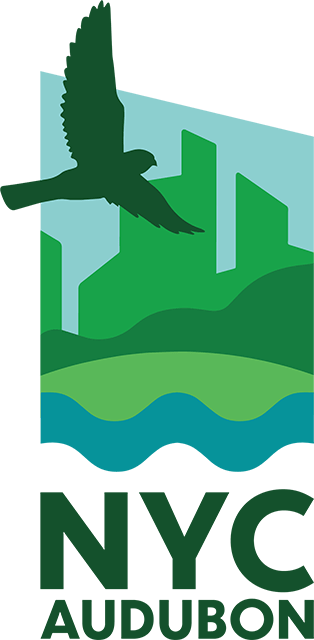Staten Island HotspotsClick on a park below to see it on the map.
Blue Heron Park
Brookfield Park
Clay Pit Ponds Park
Clove Lakes Park
Conference House Park
Fort Wadsworth
Freshkills Park
Goethals Pond Complex
Great Kills Park
Greenbelt Nature Center
Heritage Park
High Rock Park
Latourette Park
Lemon Creek Park
Long Pond Park
Midland Beach
Miller Field
Moravian Cemetery
Mount Loretto Unique Area
North Mount Loretto State Forest
Resurrection Cemetery
Richmond Terrace Park
Seaside Wildlife Nature Park
Silver Lake Park
Snug Harbor Cultural Center and Botanical Garden
William T. Davis Wildlife Refuge
Willowbrook Park
Wolfe's Pond Park
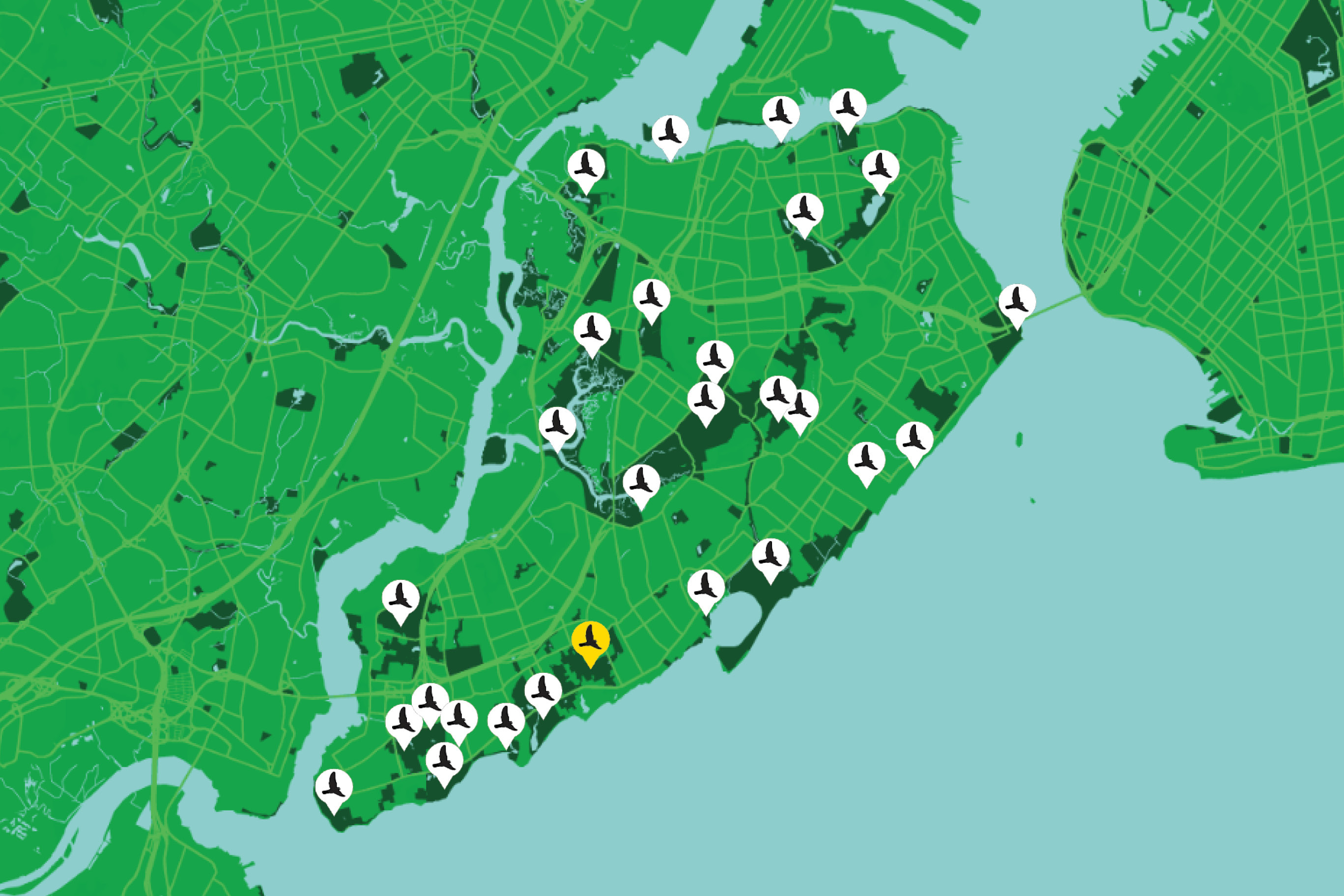
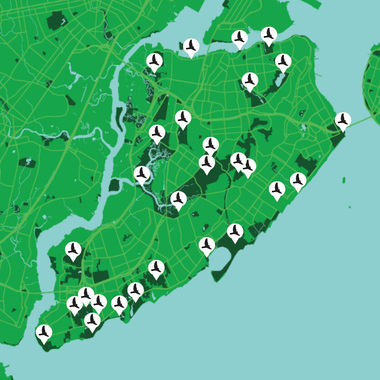
BIRDING ON STATEN ISLAND
Staten Island, also known as Richmond County, can be reached from Manhattan by a spectacular ferry ride on Upper New York Bay past the Statue of Liberty. The older generations of Staten Islanders remember a time when this ferry was still the only direct way of commuting from the City’s other boroughs, before the Verrazzano-Narrows Bridge was built in 1964. The island remained quite rural at that time—and local groups like Protectors of Pine Oak Woods, and its forerunner, SIGNAL, have fought to preserve many natural areas including Mt. Loretto Unique Area, Long Pond Park, and both the Staten Island Greenbelt and the Bluebelt. Some of NYC Audubon's early advocacy work focused on helping to protect the first Harbor Heron nesting islands in the Arthur Kill and Kill Van Kull: Prall's and Shooters Island and Isle of Meadows.
Due to its impressive diversity of habitats, Staten Island offers spectacular birding opportunities all year round. Clove Lakes Park, not far from the ferry, vies for the title of Staten Island’s most popular spring migration spot, attracting all manner of warblers, tanagers, and other songbirds; this park also hosts the City’s only nesting pair of Great Blue Herons. At the island’s center, the Staten Island Greenbelt, a 2,800-acre network of second-growth forest, is one of the healthiest forest ecosystems in the City. Great Kills Park, Wolfe’s Pond Park, Mount Loretto Nature Preserve, Long Pond Park, and Conference House Park are among the many spots along the island’s southern shore that offer spectacular coastal birding, while the gradually opening Freshkills Park joins Goethals Pond in offering wetland and grassland habitat in the island’s northwest corner. Many other hotspots dot the island's shoreline, providing abundant birding opportunities.
Staten Island’s prodigious and diverse habitats account for the over 350 species of birds documented in Staten Island (Richmond County) eBird records, a borough count second only to that of Queens. The island boasts of several unusual breeding species in recent years, including Pileated Woodpecker, Sedge Wren, Grasshopper Sparrow, Forster's Tern, and both Black and Turkey Vultures. Bald Eagles are now year-round residents on the island. Rarer species observed over the years have included Thick-billed Murre, Brown Booby, Sandhill Crane, Mississippi Kite, Eastern Whip-poor-will, Scissor-tailed Flycatcher, Western Kingbird, and Western Tanager, along with many rare gull, shorebird, and pelagic species.
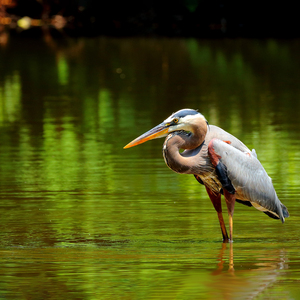
Great Blue Herons regularly nest in Clove Lakes Park, the only known breeding site for this largest of our wader species in New York City. Photo: Isaac Grant
Clove Lakes Park
A short bus ride from the Staten Island Ferry lies one of Staten Island’s famed migrant spots, Clove Lakes Park. Particularly in spring, this lovely and accessible park’s lake, ponds, streams, and hilly woodlands attract an impressive variety of warblers, vireos, tanagers, and other land birds that stop to rest and refuel. The park also provides habitat for unusual breeding species: Cooper’s Hawks nest here, as do Great Blue Herons—the only pair known to nest in New York City, and one of only a few breeding records in the past century. eBirders have recorded 220 species in Clove Lakes Park.
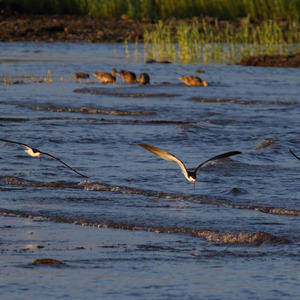
Black Skimmers fly over the waters of Great Kills Park. Photo: Lawrence Pugliares
Great Kills Park
Great Kills Park, the Staten Island unit of Gateway National Recreation Area, is the largest of a series of seaside parks along Staten Island’s southern shore. Its marshes, mudflats, dunes, beaches, and woodlands are an important stopover for birds of all kinds migrating along the island’s coast. Nesting species include Osprey, Killdeer, Boat-tailed Grackle, and Orchard Oriole. Herons and egrets nesting on nearby Harbor Heron Islands visit the park’s marshes to forage. eBirders have recorded 279 species across the different sections of Great Kills Park.
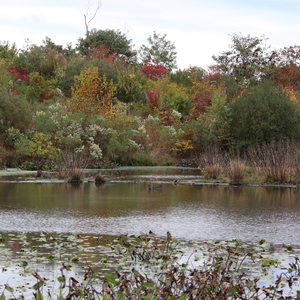
A rich pond habitat in Willowbrook Park. Photo: Dave Ostapiuk
Staten Island Greenbelt
Established in 1984 after a long fight by local conservationists, the 2,800-acre Staten Island Greenbelt includes woodlands, swamps, kettle ponds and lakes, and Todt Hill, the highest point on the eastern seaboard south of Maine. This interconnected network of preserved habitat hosts nesting woodland species such as Cooper’s Hawk, Great Horned Owl, and most recently, Pileated Woodpecker. Overseen by the Greenbelt Nature Center, the preserve includes many protected lands, including High Rock Park, Latourette Park, Willowbrook Park, the William T. Davis Wildlife Refuge, and the newest addition, Brookfield Park.
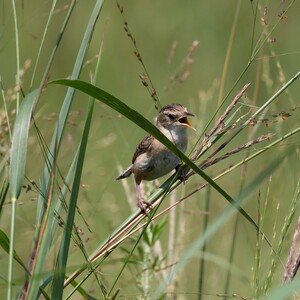
Sedge Wrens, a rare species for New York City, nested in the grassland habitat of Freshkills Park in 2020. Photo: Shannon Curley
Freshkills Park and Northwest Corridor
The northwest section of Staten Island is a vast and interconnected tidal marsh system draining into the Arthur Kill and Kill Van Kull, and includes some of the first islands colonized by herons and egrets in the late 1970s. This area has been largely dedicated to industry and waste disposal over the last century, but the gradual opening of the new Freshkills Park is allowing birders to visit and discover a new grassland ecosystem that hosts Grasshopper Sparrows and Sedge Wrens, in addition to breeding wetland species such as Forster’s Tern. (eBirders in Freshkills have already documented over 200 species.) Other preserved wetlands in this area include the Goethals Pond Complex and Mariner’s Marsh.
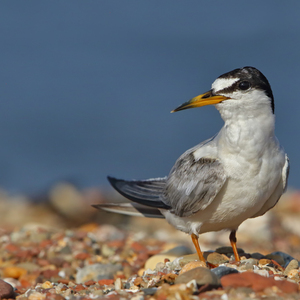
A Least Tern on Wolfe's Pond Beach. Photo: Isaac Grant
Wolfe's Pond Park
Wolfe's Pond Park's 336 acres feature woodlands of maple, oaks, and beech; ponds; and a ¾-mile stretch of dunes and cobbled shoreline. Wolfe’s Pond, a 16-acre freshwater body of water perched above the Staten Island water table, is only a short distance from oceanfront dunes. The pond is an ideal spot for night-herons, many duck species, and Belted Kingfisher. Wood Duck can be seen here in the spring and fall.
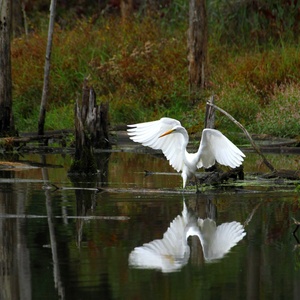
A Great Egret in Mount Loretto Unique Area's freshwater pond. Photo: Lawrence Pugliares
Mount Loretto Unique Area
This extensive natural habitat was preserved thanks to the efforts of local conservationists, much like the nearby Staten Island Greenbelt. The curiously named site includes grassland, wetlands, and woodland, as well as sandy bluffs overlooking Raritan Bay. Mount Loretto is an excellent migration spot, particularly in the fall, when raptors and sparrows pass through in good numbers. Seabirds such as loons, grebes, and Great Cormorant may be seen on the bay in the wintertime. eBirders have recorded 242 species in Mount Loretto Unique Area; rarities have included Western Grebe, Western Kingbird, and Scissor-tailed Flycatcher.
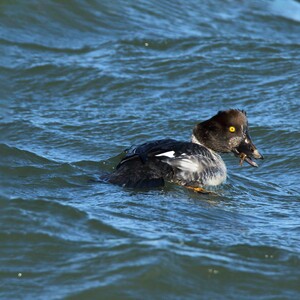
A wintering female Common Goldeneye finds a tasty morsel off the coast of Conference House Park. Photo: Isaac Grant
Conference House Park
At the southwest corner of Staten Island, the City’s southernmost point, lies Conference House Park. This spot is sometimes called “Little Cape May” for good reason: a great number and diversity of migrants flying south along the City’s southern coast in the fall reach this final point and stop to rest, before continuing over water to the New Jersey mainland and further down the coast. In the winter, this is an excellent spot to look for diving ducks such as Long-tailed Duck and Common Goldeneye, as well as winter visitors like Snow Bunting and Snowy Owl. Local eBirders have documented 227 species here, including rarities such as Scissor-tailed Flycatcher, Ash-throated Flycatcher, and Western Tanager.
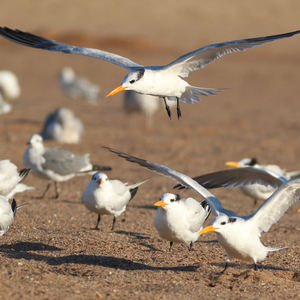
Royal Terns congregate on Midland Beach. Photo: Isaac Grant
More South S.I. Hotspots
Staten Island remained quite rural until just a few decades ago—and though much land has been developed, many important habitats have also been preserved. At the southern end of the island, a number of excellent waterside birding spots complement the south-shore parks profiled above, providing habitat for shorebirds and waterfowl, and good vantage points for birders during fall migration. These southern Staten Island spots include, west to east, Clay Pit Ponds State Park, Long Pond Park, North Mount Loretto State Forest, Resurrection Cemetery, Lemon Creek Park, Blue Heron Park, Seaside Wildlife Nature Park, Miller Field, and Midland Beach.
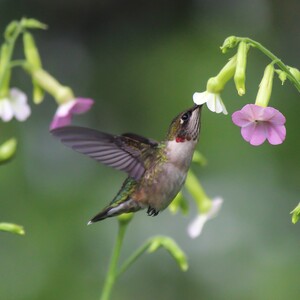
A young male Ruby-throated Hummingbird stops by Snug Harbor Botanical Garden on its way south, in late August. Photo: Dave Ostapiuk
More North S.I. Hotspots
Several additional spots attract birds and birders to the northern end of Staten Island. Fort Wadsworth, standing guard at the base of the Verrazzano-Narrows Bridge, is an excellent spot for seabirds and diving ducks, as well as fall sparrows. Silver Lake Park, contiguous with Clove Lakes Park, is a good inland stopover site during migration and also hosts wintering waterfowl. And on the island’s northern shore, three green spaces—Snug Harbor Cultural Center and Botanical Garden, Heritage Park, and Richmond Terrace Park—provide a variety of upland and wetland habitats and access to the waters of the Kill Van Kull.
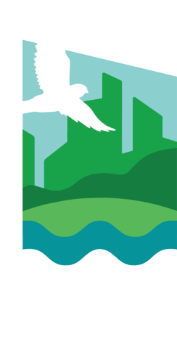
 park locations
park locations